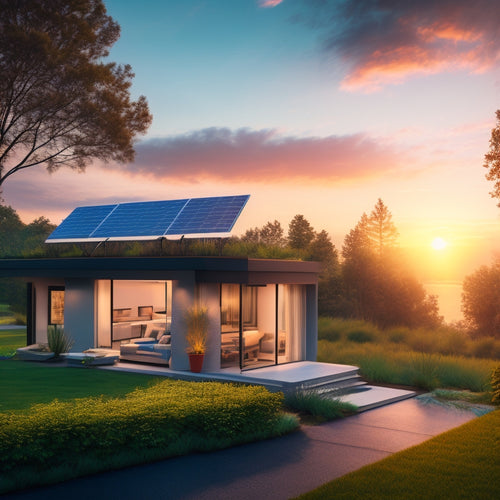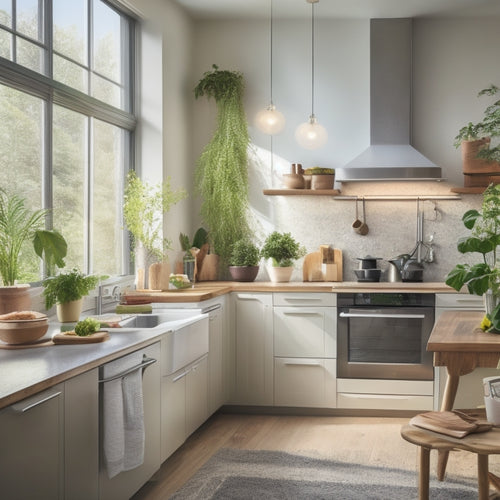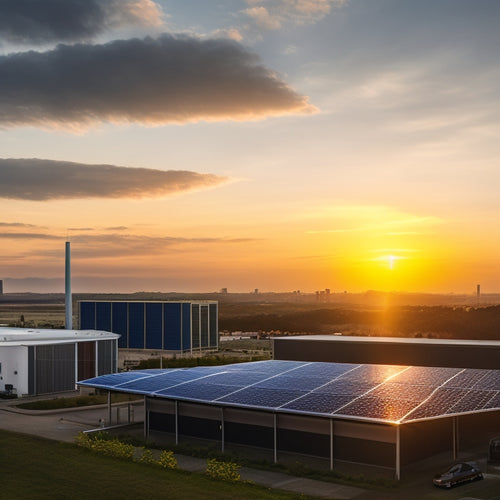
Optimizing Your Home for Renewable Energy
Share
You're taking the first step towards altering your home into a renewable energy powerhouse, where every light switch, appliance, and system work in harmony to minimize your carbon footprint and maximize your energy savings. To get started, assess your home's energy needs by conducting an energy audit to identify areas of inefficiency. Prioritize upgrades like double-glazed windows, air sealing, and energy-efficient lighting and appliances. Next, optimize your water heating system and create a customized renewable energy plan. By tackling these steps, you'll be well on your way to utilizing the full potential of renewable energy - and there's still more to investigate.
Key Takeaways
- Conduct a home energy assessment to identify areas of inefficiency and prioritize upgrades for maximum energy savings.
- Seal air leaks, upgrade windows and insulation, and address inefficient lighting and appliances to reduce energy waste.
- Implement a customized renewable energy plan based on energy audit results and usage patterns to achieve effective savings.
- Evaluate and select the most suitable renewable energy systems, such as solar or wind, for your home's specific needs and location.
- Utilize smart energy management systems to track energy usage, optimize consumption, and make informed decisions about energy use.
Assessing Your Home's Energy Needs
Optimizing Your Home for Renewable Energy
Assessing Your Home's Energy Needs
Your home's energy needs are an important factor in determining the most effective renewable energy solutions. To optimize your home for renewable energy, you need to understand your energy consumption patterns.
A home energy assessment is a vital step in this process. This assessment involves evaluating your home's energy usage, identifying areas of inefficiency, and determining the most suitable renewable energy solutions.
By analyzing your energy consumption patterns, you'll be able to pinpoint areas where energy is being wasted and identify opportunities for improvement. Conducting a thorough energy audit identifying high usage areas and performing detailed load calculations will help you gather energy usage data over a representative period, typically one year.
A thorough home energy assessment will provide you with an extensive understanding of your energy needs, enabling you to make informed decisions about the most effective renewable energy solutions for your home.
Identifying Energy-Wasting Areas
You'll want to pinpoint areas in your home where energy is being wasted, as this will help you prioritize upgrades for maximum impact.
Larger systems, for instance, can increase complexity and costs due to more components and infrastructure System Size and Complexity, so it's crucial to assess the energy density of your system.
Leaky ductwork and vents, for instance, can account for significant energy losses, while inefficient lighting fixtures can also drain your energy resources.
Leaky Ductwork and Vents
Inspecting your home's ductwork and vents is essential for identifying energy-wasting areas, as even slight leaks can greatly impact your energy consumption. Leaks in your ductwork can cause your heating and cooling system to work harder, increasing your energy bills and reducing the overall efficiency of your system.
| Duct Sealing Techniques | Vent Inspection Methods |
|---|---|
| Mastic sealant | Visual inspection with a flashlight and mirror |
| Foil tape | Infrared thermography |
| Aerosol sealant | Pressure testing |
| Ultraviolet (UV) dye | Smoke testing |
Inefficient Lighting Fixtures
Behind the walls and above the ceilings, leaky ductwork and vents are often not the only energy-wasting culprits in your home.
Another common offender is inefficient lighting fixtures, which can account for up to 10% of your energy bill. Outdated lighting technologies like incandescent bulbs and fluorescent lights are major contributors to energy waste.
Consider LED technology, which can provide significant energy savings. Lighting retrofits can be as simple as replacing existing fixtures with LED equivalents or installing smart lighting systems that learn your habits and adjust brightness accordingly.
Strategic fixture placement, color temperature selection, and dimmable switches can also optimize energy use. By implementing these solutions, you can create a layered lighting scheme that's both functional and energy-efficient.
Upgrading Windows and Insulation
As you begin upgrading your home for renewable energy, one vital aspect to focus on is the thermal envelope, which consists of your windows and insulation. This important component plays a significant role in regulating heat transfer, thereby impacting your energy consumption.
Renewable energy adoption can greatly reduce dependency on fossil fuels, leading to substantial savings in operational expenses. Additionally, a shift to renewable energy contributes to a cleaner environment through reduced carbon footprint.
When selecting new windows, consider the following types:
- Double-glazed windows for minimal heat loss
- Low-e windows for reduced heat transfer
- Fiberglass windows for durability and energy efficiency
In addition to window upgrades, it's essential to assess your insulation materials. Verify that your attic, walls, and floors are adequately insulated with materials like fiberglass batts, spray foam, or cellulose.
Improving Lighting and Appliances
How can you further reduce your energy consumption and carbon footprint after optimizing your home's thermal envelope? One effective way is to improve your lighting and appliances. Traditional incandescent bulbs and inefficient appliances can guzzle energy, but switching to smart lighting and energy-efficient alternatives can make a significant impact.
| Traditional Option | Energy-Efficient Alternative |
|---|---|
| Incandescent bulbs | LED bulbs (uses up to 90% less energy) |
| Halogen lamps | CFL bulbs (uses up to 75% less energy) |
| Old refrigerators | Energy Star-certified refrigerators (uses up to 40% less energy) |
| Conventional ovens | Induction cooktops (uses up to 50% less energy) |
| Standard water pumps | Energy-efficient water pumps (uses up to 80% less energy) |
Optimizing Your Water Heating System
After addressing your home's lighting and appliances, you can further reduce your energy consumption by focusing on your water heating system.
This system accounts for a significant portion of your energy usage, making it an ideal target for optimization. To reduce energy consumption, consider the following options:
-
Install a solar water heater: Utilize the power of the sun to heat your water, reducing your reliance on traditional energy sources.
-
Upgrade to a heat pump water heater: These units are highly efficient and can provide up to four times more energy than traditional electric water heaters.
-
Insulate your water heater and pipes: Proper insulation can reduce heat loss, ensuring that your water stays hot for longer and reducing the energy needed to reheat it.
Sealing Air Leaks and Gaps
Nearly 30% of your home's heating and cooling energy is lost due to air leaks and gaps, making this a critical area to address in your renewable energy optimization efforts.
You'll want to identify and seal all gaps and cracks around windows, doors, electrical outlets, and switches. Apply weather stripping around doors and windows to prevent air leaks. Use draft stoppers, such as foam gaskets or caulk, to seal gaps around electrical outlets and switches.
Don't forget to inspect and seal gaps in your home's foundation, walls, and ceilings. By sealing these air leaks and gaps, you'll reduce heat loss in the winter and heat gain in the summer, making your home more energy-efficient and reducing your reliance on non-renewable energy sources.
Creating a Renewable Energy Plan
Now that you've addressed air leaks and gaps, it's time to create a renewable energy plan customized to your home's specific needs.
You'll need to identify your energy audit priorities, focusing on areas that will yield the greatest energy savings.
Energy Audit Priorities
By examining your home's energy usage patterns, you'll identify areas that require the most attention during the energy audit. This vital step helps you prioritize energy-saving opportunities and create a customized plan for your smart home.
-
Lighting efficiency: Identify areas where energy-efficient lighting can make a significant impact, such as replacing traditional bulbs with LEDs or installing smart lighting systems.
-
Appliance optimization: Determine which appliances consume the most energy and investigate opportunities for upgrading to energy-efficient alternatives or optimizing their usage through smart energy management systems.
-
Insulation and air sealing: Pinpoint areas where heat escapes or enters your home, and prioritize insulation and air sealing improvements to minimize energy losses.
Energy Efficiency Goals
Three key areas to focus on when creating a renewable energy plan are setting energy efficiency goals, selecting the right renewable energy systems, and integrating these systems into your existing infrastructure.
When setting energy efficiency goals, you'll want to identify areas in your home where energy is being wasted. Look for opportunities to incorporate sustainable materials and smart technology to reduce your energy consumption.
Consider upgrading to energy-efficient appliances, insulation, and windows. You may also want to investigate smart home devices that can help you monitor and control your energy usage.
Frequently Asked Questions
Can I Install Renewable Energy Systems in a Rented Home?
Before installing renewable energy systems in a rented home, you'll need to review your rental agreements and obtain tenant permissions from your landlord, ensuring you're not violating any terms and avoiding potential disputes or lease terminations.
How Do Energy Storage Systems Like Batteries Work?
You're probably thinking energy storage systems like batteries are a modern miracle, but they're surprisingly simple: they store excess energy generated by your solar panels or wind turbines, using advanced battery technology, to enhance energy efficiency when you need it most.
Are Renewable Energy Systems Compatible With Grid Power?
You wonder if renewable energy systems can coexist with grid power; yes, they can, through grid integration, allowing you to tap into the grid when needed, while still achieving energy independence and reducing reliance on non-renewable sources.
Do Renewable Energy Systems Increase My Home's Value?
Think of renewable energy systems like a luxury kitchen upgrade - they enhance your home's value. According to the National Renewable Energy Laboratory, you can increase your property appeal by up to 17% with solar panels, yielding significant investment benefits.
Can I Install Renewable Energy Systems Myself or Diy?
You can attempt to install renewable energy systems yourself, but it's essential you possess advanced installation skills and consider safety precautions to avoid electrical shock, fire hazards, and system malfunctions that can lead to costly repairs or even injuries.
Related Posts
-

The Future of Residential Energy Storage
The future of residential energy storage looks promising and cost-effective for you. With lithium-ion battery prices ...
-

Replacing Old Appliances With Sustainable Alternatives
Replacing old appliances with sustainable alternatives can change your home into an energy-efficient space. Not only ...
-

Advantages of Commercial Solar Battery On-Site Storage
By investing in a commercial solar battery on-site storage system, you can greatly reduce your energy grid dependence...


